Analysis of Intercultural Communication at PQR Company: Report
VerifiedAdded on 2023/03/30
|9
|1617
|488
Report
AI Summary
This report analyzes the intercultural communication challenges faced by the PQR Company, an organization supporting women in difficult circumstances, based on an interview with the manager, Steffany. The report explores the importance of effective communication, persuasion, and conflict resolution within the organization. It applies organizational information theory and relational dialectics theory to evaluate the communication dynamics, highlighting the company's efforts to understand and integrate employees from diverse cultural backgrounds. The findings reveal the company's strengths in fostering open communication and addressing intercultural issues, while also identifying areas for improvement, such as strengthening relational dynamics. The report concludes with recommendations for enhancing communication through one-on-one sessions and fostering a transparent work culture, aiming to improve understanding and resolve misunderstandings within the workplace.
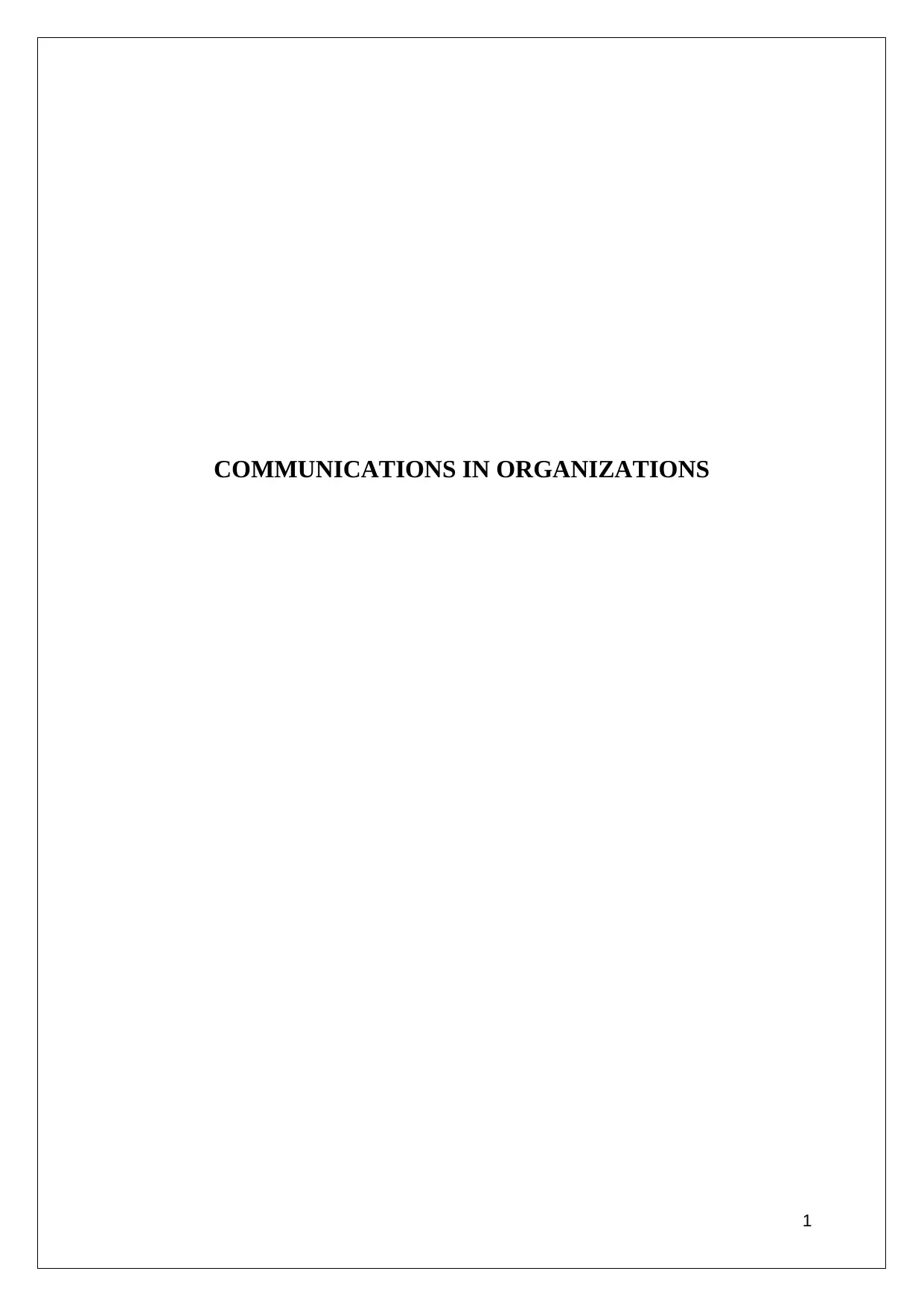
COMMUNICATIONS IN ORGANIZATIONS
1
1
Paraphrase This Document
Need a fresh take? Get an instant paraphrase of this document with our AI Paraphraser
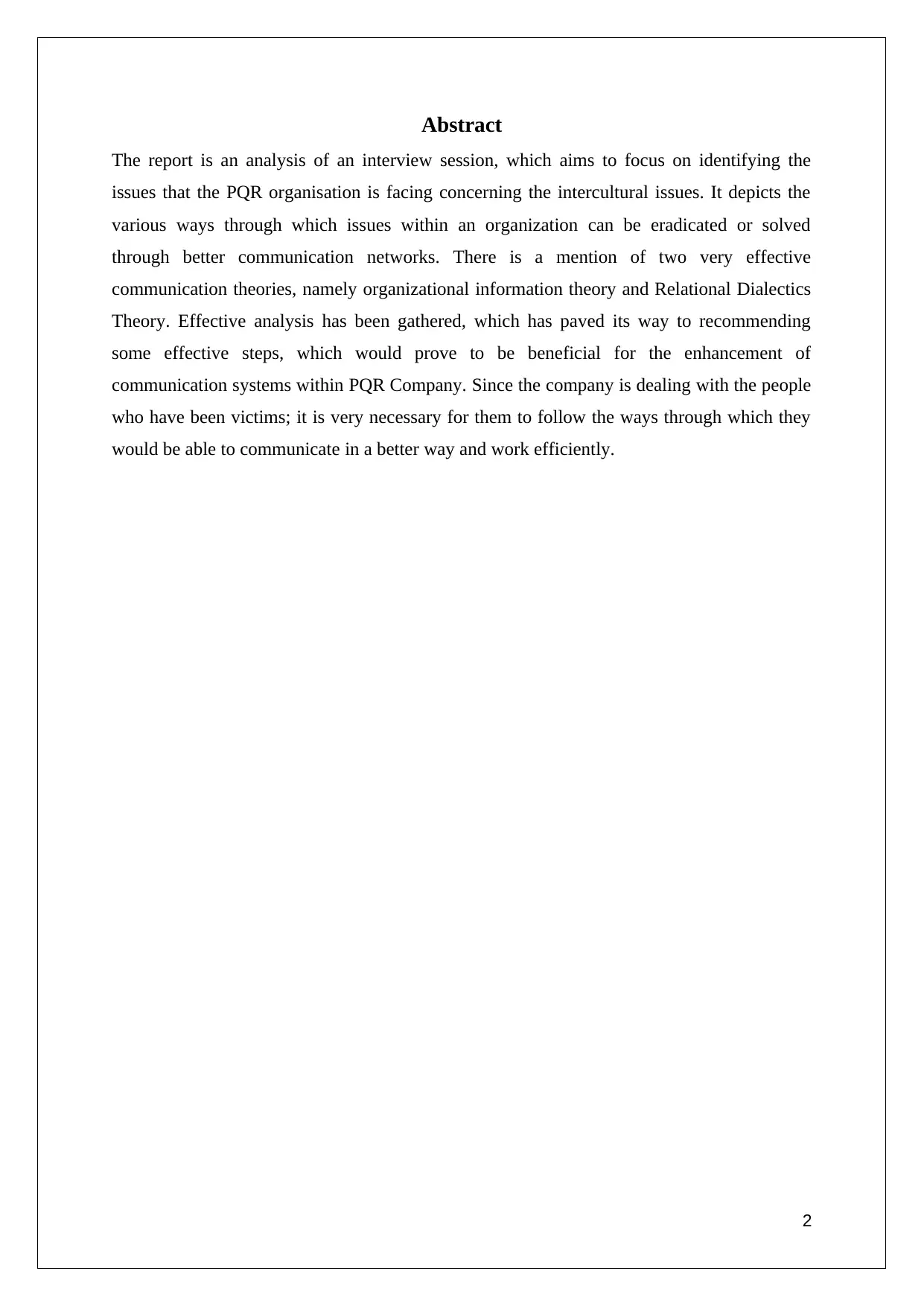
Abstract
The report is an analysis of an interview session, which aims to focus on identifying the
issues that the PQR organisation is facing concerning the intercultural issues. It depicts the
various ways through which issues within an organization can be eradicated or solved
through better communication networks. There is a mention of two very effective
communication theories, namely organizational information theory and Relational Dialectics
Theory. Effective analysis has been gathered, which has paved its way to recommending
some effective steps, which would prove to be beneficial for the enhancement of
communication systems within PQR Company. Since the company is dealing with the people
who have been victims; it is very necessary for them to follow the ways through which they
would be able to communicate in a better way and work efficiently.
2
The report is an analysis of an interview session, which aims to focus on identifying the
issues that the PQR organisation is facing concerning the intercultural issues. It depicts the
various ways through which issues within an organization can be eradicated or solved
through better communication networks. There is a mention of two very effective
communication theories, namely organizational information theory and Relational Dialectics
Theory. Effective analysis has been gathered, which has paved its way to recommending
some effective steps, which would prove to be beneficial for the enhancement of
communication systems within PQR Company. Since the company is dealing with the people
who have been victims; it is very necessary for them to follow the ways through which they
would be able to communicate in a better way and work efficiently.
2
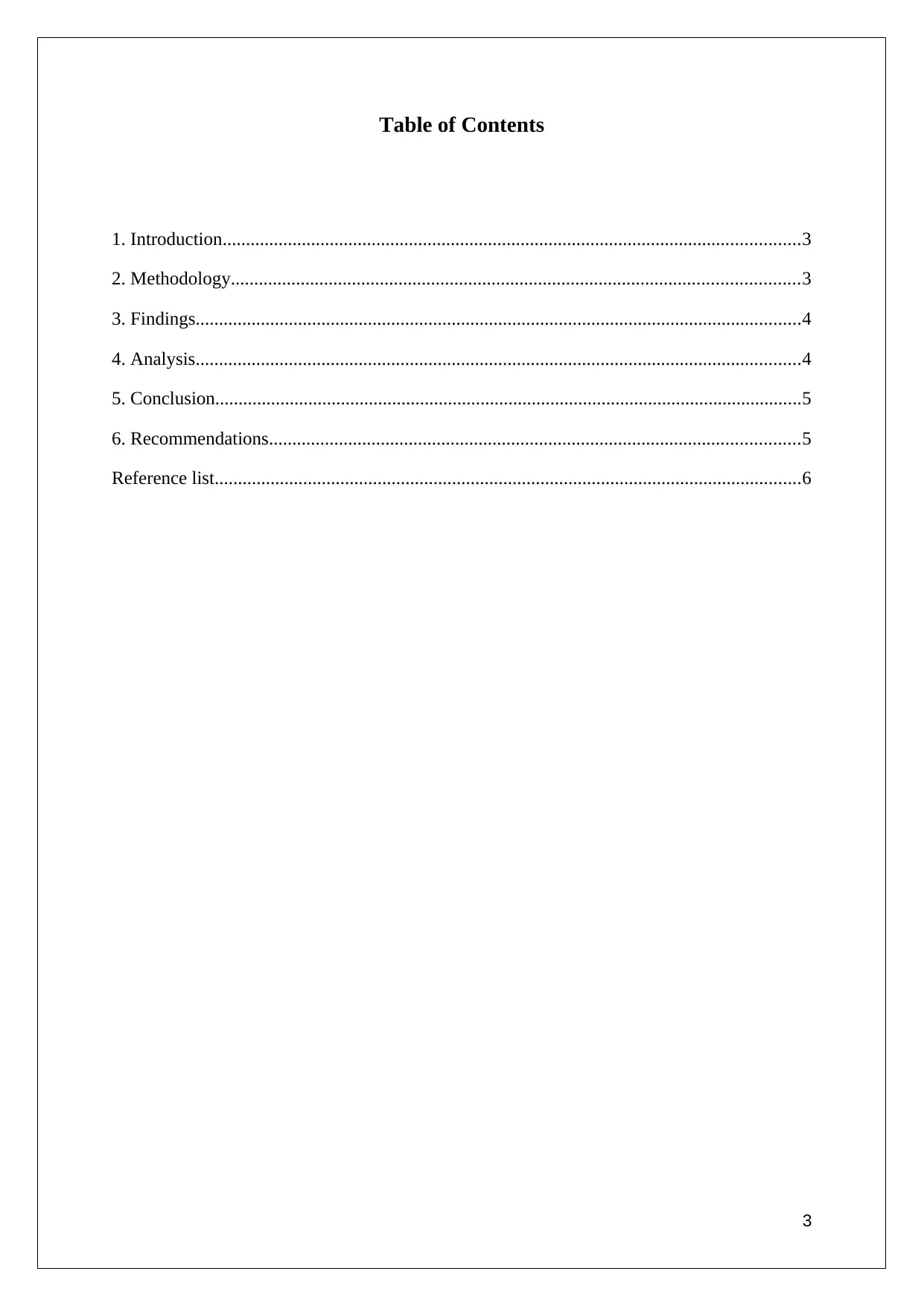
Table of Contents
1. Introduction............................................................................................................................3
2. Methodology..........................................................................................................................3
3. Findings..................................................................................................................................4
4. Analysis..................................................................................................................................4
5. Conclusion..............................................................................................................................5
6. Recommendations..................................................................................................................5
Reference list..............................................................................................................................6
3
1. Introduction............................................................................................................................3
2. Methodology..........................................................................................................................3
3. Findings..................................................................................................................................4
4. Analysis..................................................................................................................................4
5. Conclusion..............................................................................................................................5
6. Recommendations..................................................................................................................5
Reference list..............................................................................................................................6
3
⊘ This is a preview!⊘
Do you want full access?
Subscribe today to unlock all pages.

Trusted by 1+ million students worldwide
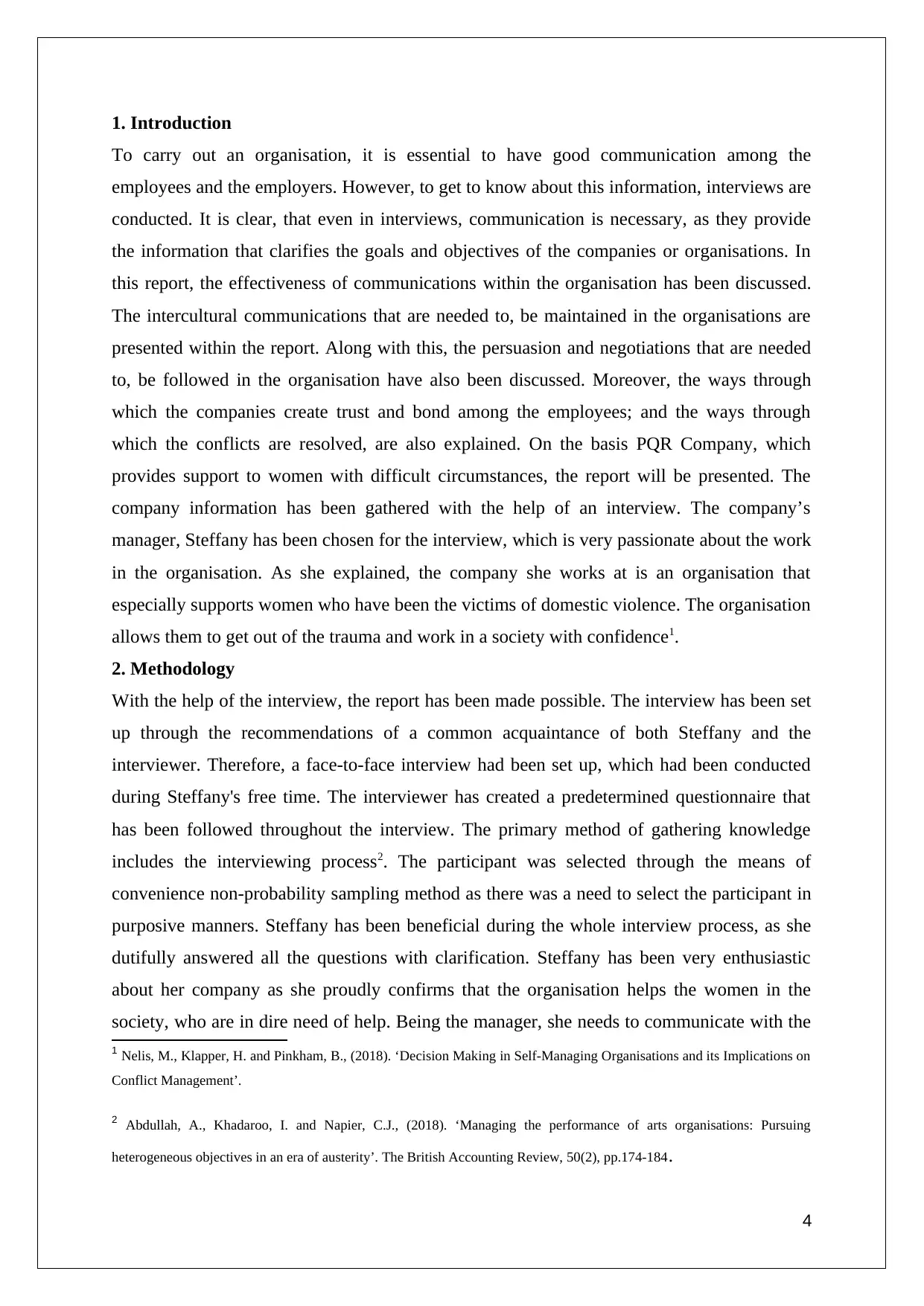
1. Introduction
To carry out an organisation, it is essential to have good communication among the
employees and the employers. However, to get to know about this information, interviews are
conducted. It is clear, that even in interviews, communication is necessary, as they provide
the information that clarifies the goals and objectives of the companies or organisations. In
this report, the effectiveness of communications within the organisation has been discussed.
The intercultural communications that are needed to, be maintained in the organisations are
presented within the report. Along with this, the persuasion and negotiations that are needed
to, be followed in the organisation have also been discussed. Moreover, the ways through
which the companies create trust and bond among the employees; and the ways through
which the conflicts are resolved, are also explained. On the basis PQR Company, which
provides support to women with difficult circumstances, the report will be presented. The
company information has been gathered with the help of an interview. The company’s
manager, Steffany has been chosen for the interview, which is very passionate about the work
in the organisation. As she explained, the company she works at is an organisation that
especially supports women who have been the victims of domestic violence. The organisation
allows them to get out of the trauma and work in a society with confidence1.
2. Methodology
With the help of the interview, the report has been made possible. The interview has been set
up through the recommendations of a common acquaintance of both Steffany and the
interviewer. Therefore, a face-to-face interview had been set up, which had been conducted
during Steffany's free time. The interviewer has created a predetermined questionnaire that
has been followed throughout the interview. The primary method of gathering knowledge
includes the interviewing process2. The participant was selected through the means of
convenience non-probability sampling method as there was a need to select the participant in
purposive manners. Steffany has been beneficial during the whole interview process, as she
dutifully answered all the questions with clarification. Steffany has been very enthusiastic
about her company as she proudly confirms that the organisation helps the women in the
society, who are in dire need of help. Being the manager, she needs to communicate with the
1 Nelis, M., Klapper, H. and Pinkham, B., (2018). ‘Decision Making in Self-Managing Organisations and its Implications on
Conflict Management’.
2 Abdullah, A., Khadaroo, I. and Napier, C.J., (2018). ‘Managing the performance of arts organisations: Pursuing
heterogeneous objectives in an era of austerity’. The British Accounting Review, 50(2), pp.174-184.
4
To carry out an organisation, it is essential to have good communication among the
employees and the employers. However, to get to know about this information, interviews are
conducted. It is clear, that even in interviews, communication is necessary, as they provide
the information that clarifies the goals and objectives of the companies or organisations. In
this report, the effectiveness of communications within the organisation has been discussed.
The intercultural communications that are needed to, be maintained in the organisations are
presented within the report. Along with this, the persuasion and negotiations that are needed
to, be followed in the organisation have also been discussed. Moreover, the ways through
which the companies create trust and bond among the employees; and the ways through
which the conflicts are resolved, are also explained. On the basis PQR Company, which
provides support to women with difficult circumstances, the report will be presented. The
company information has been gathered with the help of an interview. The company’s
manager, Steffany has been chosen for the interview, which is very passionate about the work
in the organisation. As she explained, the company she works at is an organisation that
especially supports women who have been the victims of domestic violence. The organisation
allows them to get out of the trauma and work in a society with confidence1.
2. Methodology
With the help of the interview, the report has been made possible. The interview has been set
up through the recommendations of a common acquaintance of both Steffany and the
interviewer. Therefore, a face-to-face interview had been set up, which had been conducted
during Steffany's free time. The interviewer has created a predetermined questionnaire that
has been followed throughout the interview. The primary method of gathering knowledge
includes the interviewing process2. The participant was selected through the means of
convenience non-probability sampling method as there was a need to select the participant in
purposive manners. Steffany has been beneficial during the whole interview process, as she
dutifully answered all the questions with clarification. Steffany has been very enthusiastic
about her company as she proudly confirms that the organisation helps the women in the
society, who are in dire need of help. Being the manager, she needs to communicate with the
1 Nelis, M., Klapper, H. and Pinkham, B., (2018). ‘Decision Making in Self-Managing Organisations and its Implications on
Conflict Management’.
2 Abdullah, A., Khadaroo, I. and Napier, C.J., (2018). ‘Managing the performance of arts organisations: Pursuing
heterogeneous objectives in an era of austerity’. The British Accounting Review, 50(2), pp.174-184.
4
Paraphrase This Document
Need a fresh take? Get an instant paraphrase of this document with our AI Paraphraser
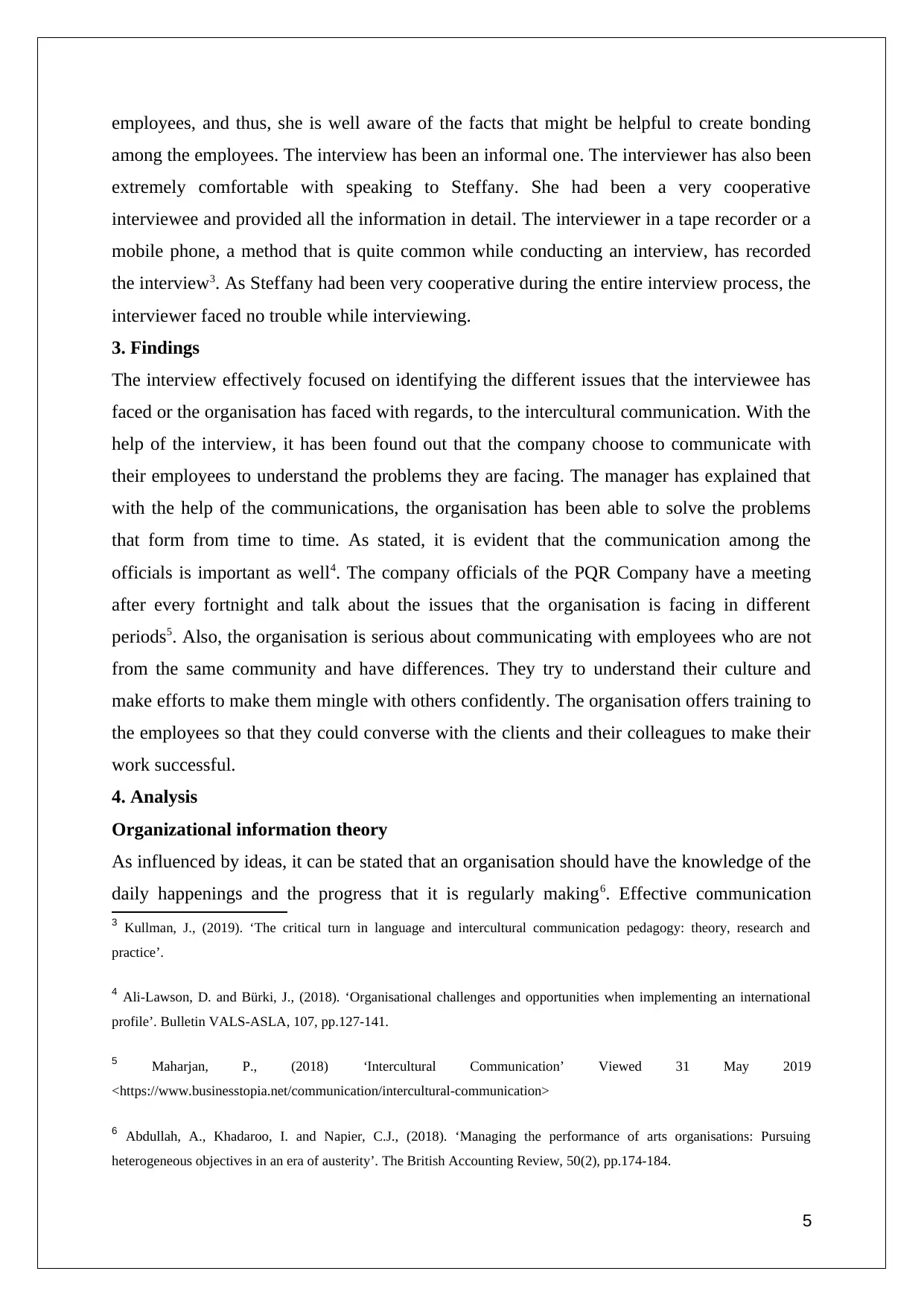
employees, and thus, she is well aware of the facts that might be helpful to create bonding
among the employees. The interview has been an informal one. The interviewer has also been
extremely comfortable with speaking to Steffany. She had been a very cooperative
interviewee and provided all the information in detail. The interviewer in a tape recorder or a
mobile phone, a method that is quite common while conducting an interview, has recorded
the interview3. As Steffany had been very cooperative during the entire interview process, the
interviewer faced no trouble while interviewing.
3. Findings
The interview effectively focused on identifying the different issues that the interviewee has
faced or the organisation has faced with regards, to the intercultural communication. With the
help of the interview, it has been found out that the company choose to communicate with
their employees to understand the problems they are facing. The manager has explained that
with the help of the communications, the organisation has been able to solve the problems
that form from time to time. As stated, it is evident that the communication among the
officials is important as well4. The company officials of the PQR Company have a meeting
after every fortnight and talk about the issues that the organisation is facing in different
periods5. Also, the organisation is serious about communicating with employees who are not
from the same community and have differences. They try to understand their culture and
make efforts to make them mingle with others confidently. The organisation offers training to
the employees so that they could converse with the clients and their colleagues to make their
work successful.
4. Analysis
Organizational information theory
As influenced by ideas, it can be stated that an organisation should have the knowledge of the
daily happenings and the progress that it is regularly making6. Effective communication
3 Kullman, J., (2019). ‘The critical turn in language and intercultural communication pedagogy: theory, research and
practice’.
4 Ali-Lawson, D. and Bürki, J., (2018). ‘Organisational challenges and opportunities when implementing an international
profile’. Bulletin VALS-ASLA, 107, pp.127-141.
5 Maharjan, P., (2018) ‘Intercultural Communication’ Viewed 31 May 2019
<https://www.businesstopia.net/communication/intercultural-communication>
6 Abdullah, A., Khadaroo, I. and Napier, C.J., (2018). ‘Managing the performance of arts organisations: Pursuing
heterogeneous objectives in an era of austerity’. The British Accounting Review, 50(2), pp.174-184.
5
among the employees. The interview has been an informal one. The interviewer has also been
extremely comfortable with speaking to Steffany. She had been a very cooperative
interviewee and provided all the information in detail. The interviewer in a tape recorder or a
mobile phone, a method that is quite common while conducting an interview, has recorded
the interview3. As Steffany had been very cooperative during the entire interview process, the
interviewer faced no trouble while interviewing.
3. Findings
The interview effectively focused on identifying the different issues that the interviewee has
faced or the organisation has faced with regards, to the intercultural communication. With the
help of the interview, it has been found out that the company choose to communicate with
their employees to understand the problems they are facing. The manager has explained that
with the help of the communications, the organisation has been able to solve the problems
that form from time to time. As stated, it is evident that the communication among the
officials is important as well4. The company officials of the PQR Company have a meeting
after every fortnight and talk about the issues that the organisation is facing in different
periods5. Also, the organisation is serious about communicating with employees who are not
from the same community and have differences. They try to understand their culture and
make efforts to make them mingle with others confidently. The organisation offers training to
the employees so that they could converse with the clients and their colleagues to make their
work successful.
4. Analysis
Organizational information theory
As influenced by ideas, it can be stated that an organisation should have the knowledge of the
daily happenings and the progress that it is regularly making6. Effective communication
3 Kullman, J., (2019). ‘The critical turn in language and intercultural communication pedagogy: theory, research and
practice’.
4 Ali-Lawson, D. and Bürki, J., (2018). ‘Organisational challenges and opportunities when implementing an international
profile’. Bulletin VALS-ASLA, 107, pp.127-141.
5 Maharjan, P., (2018) ‘Intercultural Communication’ Viewed 31 May 2019
<https://www.businesstopia.net/communication/intercultural-communication>
6 Abdullah, A., Khadaroo, I. and Napier, C.J., (2018). ‘Managing the performance of arts organisations: Pursuing
heterogeneous objectives in an era of austerity’. The British Accounting Review, 50(2), pp.174-184.
5
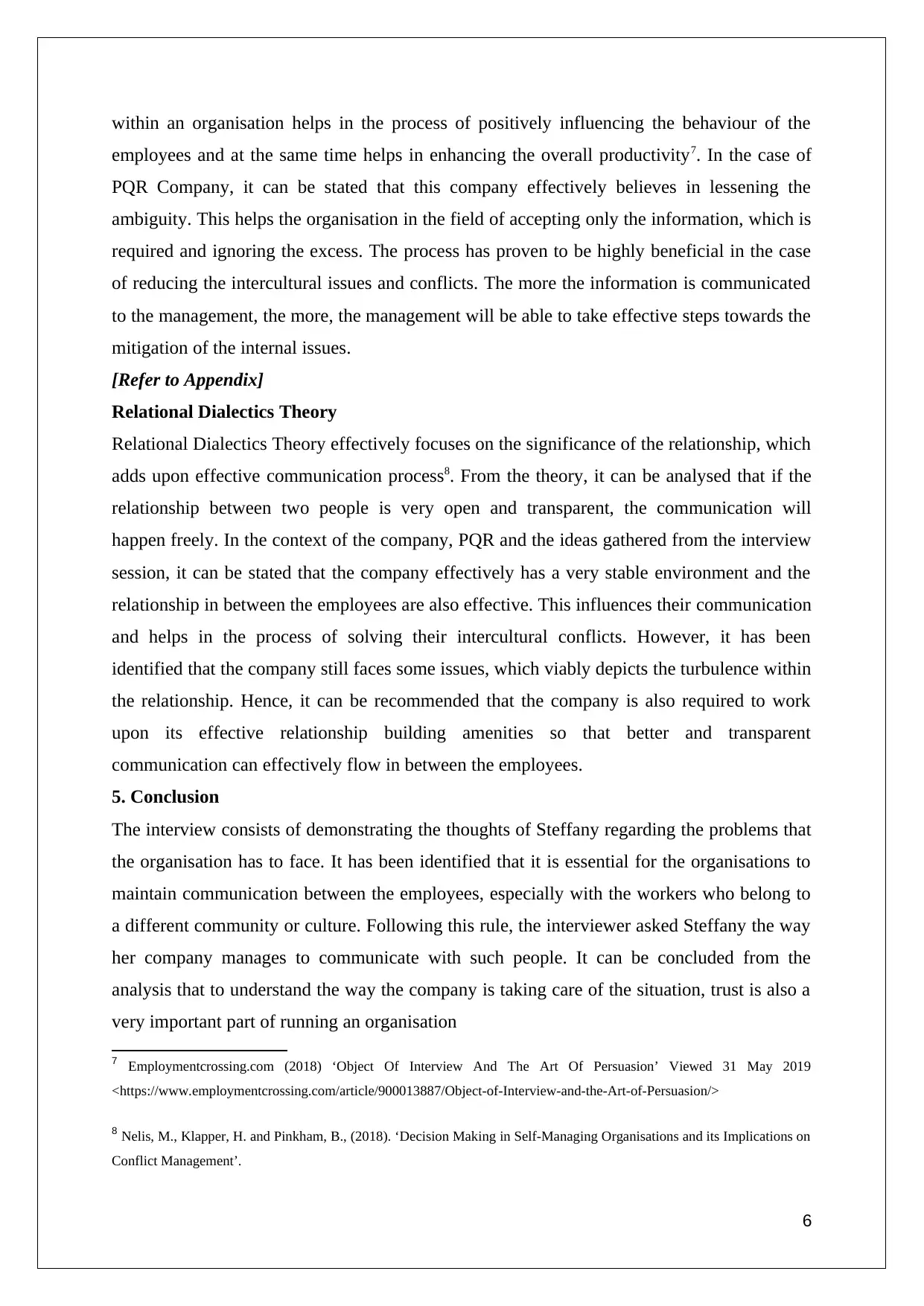
within an organisation helps in the process of positively influencing the behaviour of the
employees and at the same time helps in enhancing the overall productivity7. In the case of
PQR Company, it can be stated that this company effectively believes in lessening the
ambiguity. This helps the organisation in the field of accepting only the information, which is
required and ignoring the excess. The process has proven to be highly beneficial in the case
of reducing the intercultural issues and conflicts. The more the information is communicated
to the management, the more, the management will be able to take effective steps towards the
mitigation of the internal issues.
[Refer to Appendix]
Relational Dialectics Theory
Relational Dialectics Theory effectively focuses on the significance of the relationship, which
adds upon effective communication process8. From the theory, it can be analysed that if the
relationship between two people is very open and transparent, the communication will
happen freely. In the context of the company, PQR and the ideas gathered from the interview
session, it can be stated that the company effectively has a very stable environment and the
relationship in between the employees are also effective. This influences their communication
and helps in the process of solving their intercultural conflicts. However, it has been
identified that the company still faces some issues, which viably depicts the turbulence within
the relationship. Hence, it can be recommended that the company is also required to work
upon its effective relationship building amenities so that better and transparent
communication can effectively flow in between the employees.
5. Conclusion
The interview consists of demonstrating the thoughts of Steffany regarding the problems that
the organisation has to face. It has been identified that it is essential for the organisations to
maintain communication between the employees, especially with the workers who belong to
a different community or culture. Following this rule, the interviewer asked Steffany the way
her company manages to communicate with such people. It can be concluded from the
analysis that to understand the way the company is taking care of the situation, trust is also a
very important part of running an organisation
7 Employmentcrossing.com (2018) ‘Object Of Interview And The Art Of Persuasion’ Viewed 31 May 2019
<https://www.employmentcrossing.com/article/900013887/Object-of-Interview-and-the-Art-of-Persuasion/>
8 Nelis, M., Klapper, H. and Pinkham, B., (2018). ‘Decision Making in Self-Managing Organisations and its Implications on
Conflict Management’.
6
employees and at the same time helps in enhancing the overall productivity7. In the case of
PQR Company, it can be stated that this company effectively believes in lessening the
ambiguity. This helps the organisation in the field of accepting only the information, which is
required and ignoring the excess. The process has proven to be highly beneficial in the case
of reducing the intercultural issues and conflicts. The more the information is communicated
to the management, the more, the management will be able to take effective steps towards the
mitigation of the internal issues.
[Refer to Appendix]
Relational Dialectics Theory
Relational Dialectics Theory effectively focuses on the significance of the relationship, which
adds upon effective communication process8. From the theory, it can be analysed that if the
relationship between two people is very open and transparent, the communication will
happen freely. In the context of the company, PQR and the ideas gathered from the interview
session, it can be stated that the company effectively has a very stable environment and the
relationship in between the employees are also effective. This influences their communication
and helps in the process of solving their intercultural conflicts. However, it has been
identified that the company still faces some issues, which viably depicts the turbulence within
the relationship. Hence, it can be recommended that the company is also required to work
upon its effective relationship building amenities so that better and transparent
communication can effectively flow in between the employees.
5. Conclusion
The interview consists of demonstrating the thoughts of Steffany regarding the problems that
the organisation has to face. It has been identified that it is essential for the organisations to
maintain communication between the employees, especially with the workers who belong to
a different community or culture. Following this rule, the interviewer asked Steffany the way
her company manages to communicate with such people. It can be concluded from the
analysis that to understand the way the company is taking care of the situation, trust is also a
very important part of running an organisation
7 Employmentcrossing.com (2018) ‘Object Of Interview And The Art Of Persuasion’ Viewed 31 May 2019
<https://www.employmentcrossing.com/article/900013887/Object-of-Interview-and-the-Art-of-Persuasion/>
8 Nelis, M., Klapper, H. and Pinkham, B., (2018). ‘Decision Making in Self-Managing Organisations and its Implications on
Conflict Management’.
6
⊘ This is a preview!⊘
Do you want full access?
Subscribe today to unlock all pages.

Trusted by 1+ million students worldwide
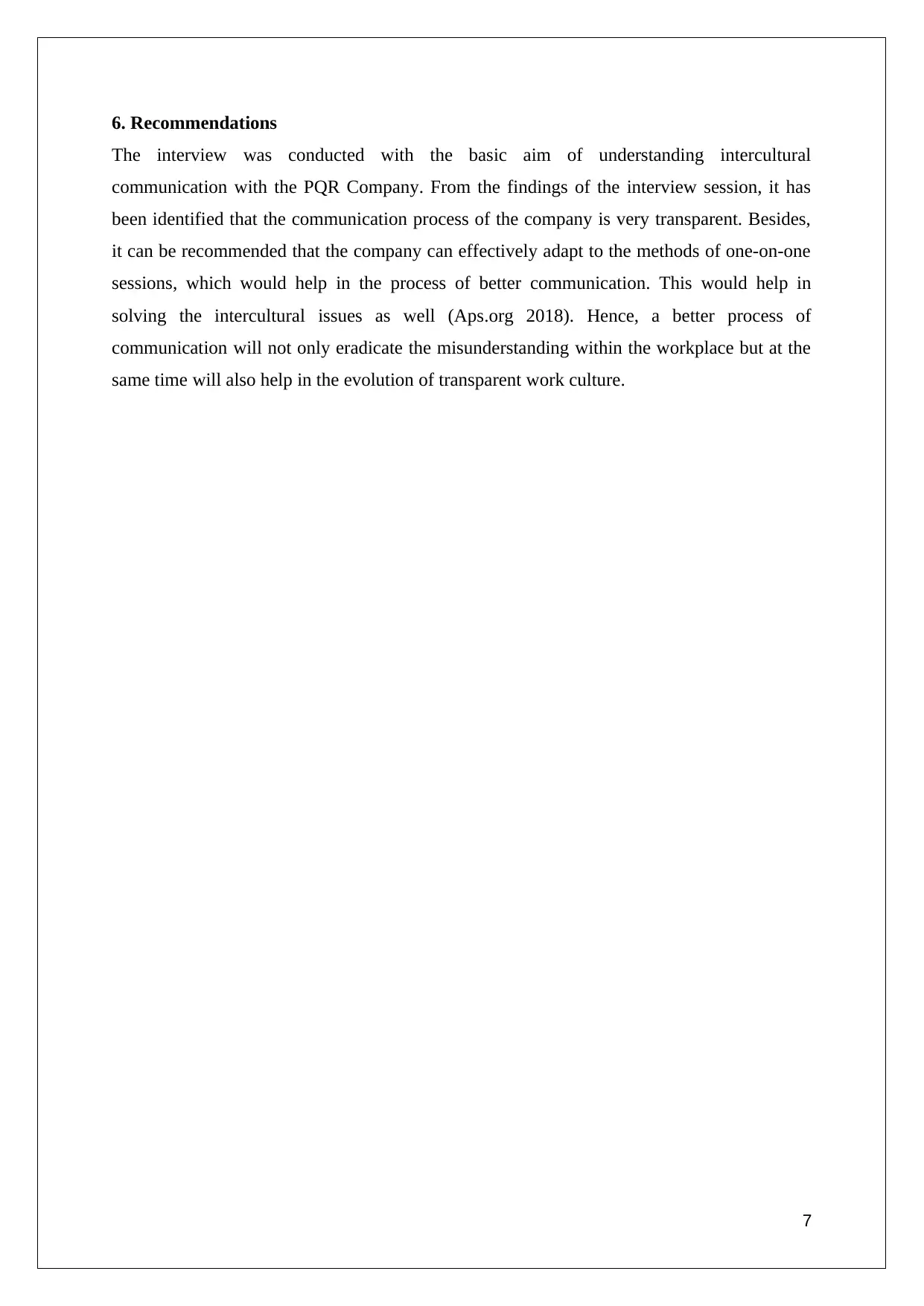
6. Recommendations
The interview was conducted with the basic aim of understanding intercultural
communication with the PQR Company. From the findings of the interview session, it has
been identified that the communication process of the company is very transparent. Besides,
it can be recommended that the company can effectively adapt to the methods of one-on-one
sessions, which would help in the process of better communication. This would help in
solving the intercultural issues as well (Aps.org 2018). Hence, a better process of
communication will not only eradicate the misunderstanding within the workplace but at the
same time will also help in the evolution of transparent work culture.
7
The interview was conducted with the basic aim of understanding intercultural
communication with the PQR Company. From the findings of the interview session, it has
been identified that the communication process of the company is very transparent. Besides,
it can be recommended that the company can effectively adapt to the methods of one-on-one
sessions, which would help in the process of better communication. This would help in
solving the intercultural issues as well (Aps.org 2018). Hence, a better process of
communication will not only eradicate the misunderstanding within the workplace but at the
same time will also help in the evolution of transparent work culture.
7
Paraphrase This Document
Need a fresh take? Get an instant paraphrase of this document with our AI Paraphraser
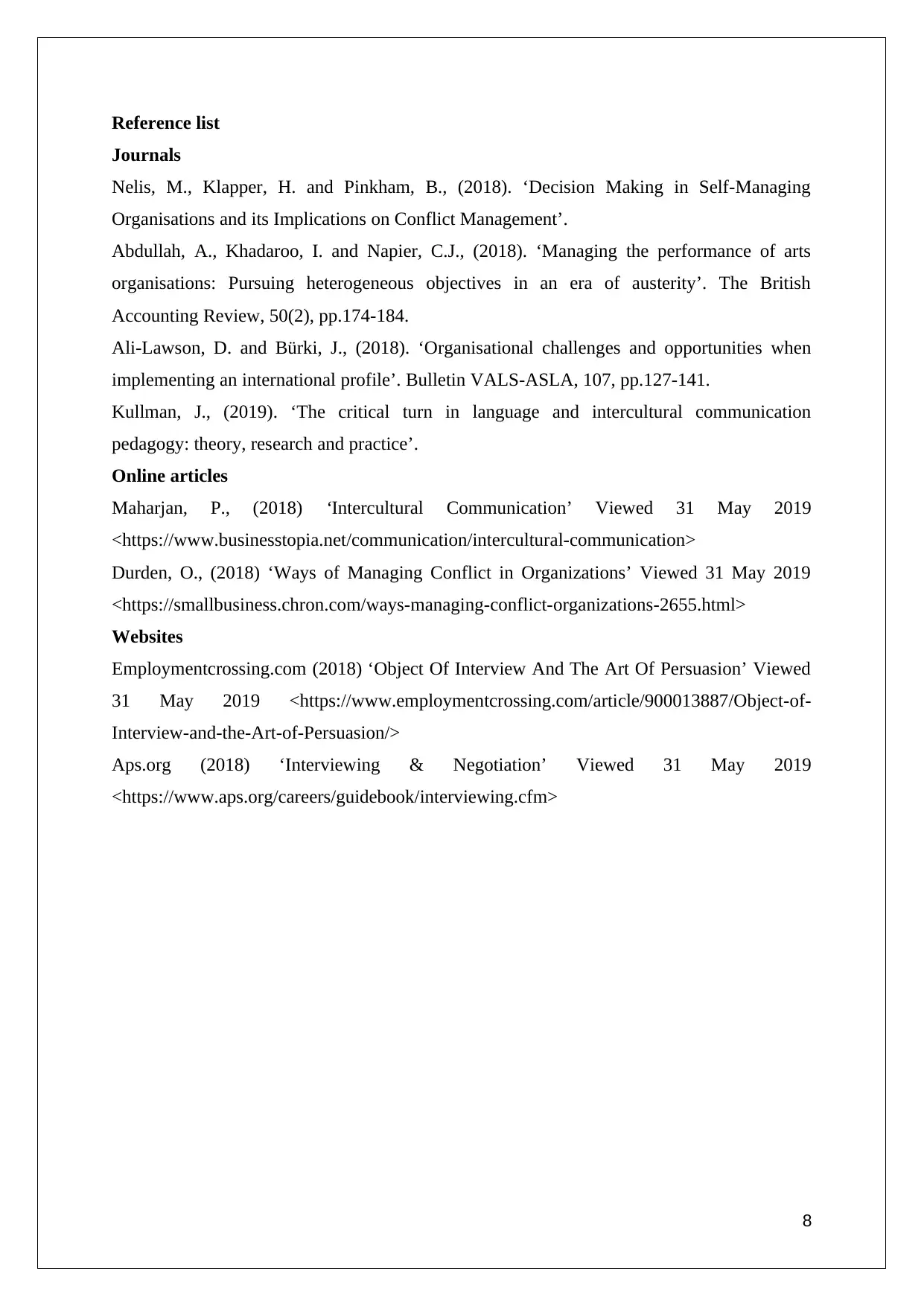
Reference list
Journals
Nelis, M., Klapper, H. and Pinkham, B., (2018). ‘Decision Making in Self-Managing
Organisations and its Implications on Conflict Management’.
Abdullah, A., Khadaroo, I. and Napier, C.J., (2018). ‘Managing the performance of arts
organisations: Pursuing heterogeneous objectives in an era of austerity’. The British
Accounting Review, 50(2), pp.174-184.
Ali-Lawson, D. and Bürki, J., (2018). ‘Organisational challenges and opportunities when
implementing an international profile’. Bulletin VALS-ASLA, 107, pp.127-141.
Kullman, J., (2019). ‘The critical turn in language and intercultural communication
pedagogy: theory, research and practice’.
Online articles
Maharjan, P., (2018) ‘Intercultural Communication’ Viewed 31 May 2019
<https://www.businesstopia.net/communication/intercultural-communication>
Durden, O., (2018) ‘Ways of Managing Conflict in Organizations’ Viewed 31 May 2019
<https://smallbusiness.chron.com/ways-managing-conflict-organizations-2655.html>
Websites
Employmentcrossing.com (2018) ‘Object Of Interview And The Art Of Persuasion’ Viewed
31 May 2019 <https://www.employmentcrossing.com/article/900013887/Object-of-
Interview-and-the-Art-of-Persuasion/>
Aps.org (2018) ‘Interviewing & Negotiation’ Viewed 31 May 2019
<https://www.aps.org/careers/guidebook/interviewing.cfm>
8
Journals
Nelis, M., Klapper, H. and Pinkham, B., (2018). ‘Decision Making in Self-Managing
Organisations and its Implications on Conflict Management’.
Abdullah, A., Khadaroo, I. and Napier, C.J., (2018). ‘Managing the performance of arts
organisations: Pursuing heterogeneous objectives in an era of austerity’. The British
Accounting Review, 50(2), pp.174-184.
Ali-Lawson, D. and Bürki, J., (2018). ‘Organisational challenges and opportunities when
implementing an international profile’. Bulletin VALS-ASLA, 107, pp.127-141.
Kullman, J., (2019). ‘The critical turn in language and intercultural communication
pedagogy: theory, research and practice’.
Online articles
Maharjan, P., (2018) ‘Intercultural Communication’ Viewed 31 May 2019
<https://www.businesstopia.net/communication/intercultural-communication>
Durden, O., (2018) ‘Ways of Managing Conflict in Organizations’ Viewed 31 May 2019
<https://smallbusiness.chron.com/ways-managing-conflict-organizations-2655.html>
Websites
Employmentcrossing.com (2018) ‘Object Of Interview And The Art Of Persuasion’ Viewed
31 May 2019 <https://www.employmentcrossing.com/article/900013887/Object-of-
Interview-and-the-Art-of-Persuasion/>
Aps.org (2018) ‘Interviewing & Negotiation’ Viewed 31 May 2019
<https://www.aps.org/careers/guidebook/interviewing.cfm>
8
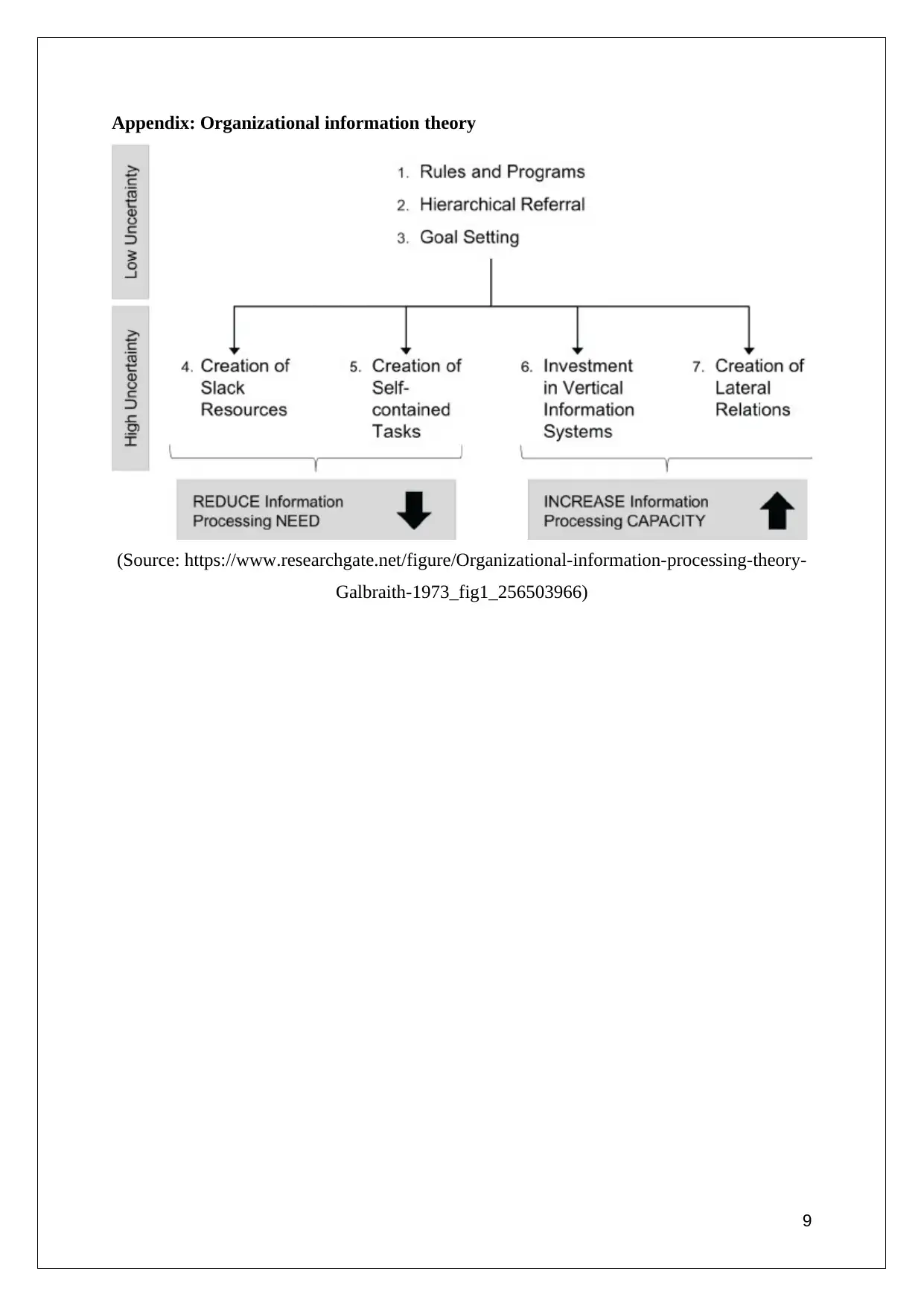
Appendix: Organizational information theory
(Source: https://www.researchgate.net/figure/Organizational-information-processing-theory-
Galbraith-1973_fig1_256503966)
9
(Source: https://www.researchgate.net/figure/Organizational-information-processing-theory-
Galbraith-1973_fig1_256503966)
9
⊘ This is a preview!⊘
Do you want full access?
Subscribe today to unlock all pages.

Trusted by 1+ million students worldwide
1 out of 9
Related Documents
Your All-in-One AI-Powered Toolkit for Academic Success.
+13062052269
info@desklib.com
Available 24*7 on WhatsApp / Email
![[object Object]](/_next/static/media/star-bottom.7253800d.svg)
Unlock your academic potential
Copyright © 2020–2025 A2Z Services. All Rights Reserved. Developed and managed by ZUCOL.




